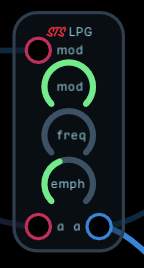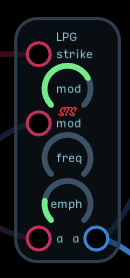V2.0 
V2.1 
Low Pass Gate
My initial attempt to model a low pass gate used a 2nd order biquad filter element, but I discovered it was unstable at low frequencies. I then tried creating a model based on the paper by J. Parker and S. D Angelo but I encountered overflow issues using their model with 32 bit calculations. In the end I decided to wing it and used a state variable filter design. Since the SVF has a 12 dB slope and the original Buchla unit is closer to 6 dB, it isn’t a particularly accurate model of the Buchla unit but I’m happy with the sound. Additionally the original Buchla design had a switch that allowed a selection of different modes, LP, VCA or both. Since we already have pretty good designs for stand-alone VCFs and VCAs I chose to implement the “both” mode only. The original design was only resonant when in LP mode and the resonance was fairly mild. This model is resonant in the combined mode and the resonance is adjustable. I initially chose the attack and decay times for the vactrol simulator based on the VTL5C3 vactrol data sheet but later doubled them based on the final sound. They can easily be adjusted if needed.
09/10/2019 @futureaztec mentioned that the MakeNoise LxD had a “strike” input allowing you to easily send a short pulse into the LPG control circuit. I thought it was a neat idea so I added one. The original model is still available.
I/O
| Input |
Signal Range |
Notes |
| strike |
0 to 1 gate |
a gate on this input will generate a short pulse to the LPG control circuit (V2.1 only) |
| mod |
0 to 1 |
modulation input - attenuated by the mod knob |
| a |
-1 to 1 |
audio input |
| Output |
Signal Range |
Notes |
| a |
-1 to 1 |
audio output |
Controls
| Control |
Function |
Notes |
| mod |
attenuator for the mod input |
|
| freq |
adjusts the cutoff frequency and gain |
this value is added to the attenuated mod input |
| emph |
emphasis (resonance) |
adjusts the filter resonance |
Displays
none
Version History
Demos
7 Likes
This thing is incredible! Happy Friday, everyone! Can’t wait to dig into this more over the weekend  Great work @stschoen! Where do you get the data sheets that explain in depth the inner workings of the things like VCO, VCF, VCA, etc.? I have been just sorta making things based on feel, as I had no idea there would be published resources that explained how these things work. I would love to be able to dive deep and gain a better understanding of the inner workings so I can make better models…
Great work @stschoen! Where do you get the data sheets that explain in depth the inner workings of the things like VCO, VCF, VCA, etc.? I have been just sorta making things based on feel, as I had no idea there would be published resources that explained how these things work. I would love to be able to dive deep and gain a better understanding of the inner workings so I can make better models…
In this case I started from this paper:
Buchla Low Pass Gate.pdf (627.7 KB)
and this data sheet:
vtl5c3c4.pdf (97.6 KB)
When trying to emulate a particular hardware module, I find the best source of information is usually the manual. Fortunately most are available online these days. Muff Wiggler and the other synth sites are also a good source of info. If you are interested in digital filters, Zavalishin’s and Pirkle’s papers are pretty good if you can slog through the math. There’s a ton of good stuff in the Learn category on the forum.
1 Like
New version - @futureaztec asked about the strike input available on the Make Noise LxD. From reading the docs it appears that this generates a short fixed-width pulse to “ping” the LPG. V2.1 has a similar feature. The pulse width is currently 0.08 secs but it’s easily modified.
The V2.1 demo uses the strike to open the gate at each clock and one of the gates from the uTuring to randomly open the mod input using an AR envelope.
3 Likes
I like the way you used the gate pattern generator to clock the uTuring. It made for an interesting rhythm. Using an LFO into the FSK input on the oscillator was also a nice touch. The FSK is really a morph between the two oscillators. It’s usually driven at audio rates, but there’s no reason why you can’t modulate it much slower. Always good to learn a new technique. I’ve found that I tend to use the FSK oscillator as my “go-to” module. It has a lot of character to the sound without chewing up a lot of CPU. The RCWG is a neat project but it’s sometimes overkill.
2 Likes
It definitely makes more sense in a CPU free ecosystem like a modular case.
I generally prefer smaller, single purpose modules that can be connected as required rather than the more complex units. I think they certainly have a place in a hardware environment where they can often provide things that would be difficult to achieve otherwise but often in our virtual environment much of the module is unused but still taking CPU cycles. In a hardware Eurorack environment you have three limiting factors, rack space, power supply and money. A multipurpose module can often save on all three. In our case the only limiting factor is CPU cycles so it makes sense to be conservative. Even so, it was a fun project and I’ve enjoyed twiddling the knobs. 
2 Likes
Definitely the correct measure for success. Personally I find complex oscillators interesting as they are an adapted design for the hardware modular ecosystem. They have many elements of the fixed architecture synth but stop just shy of being a complete synth voice. It’s really just complex enough to be at the central building block of many possible synth voices.
So I would say I use ideas I’ve borrowed from complex oscillators all the time in Audulus, but rarely all at once. But it’s fun to do every once in a while.
2 Likes
The Devil’s Ice Cream truck. 

